Contact
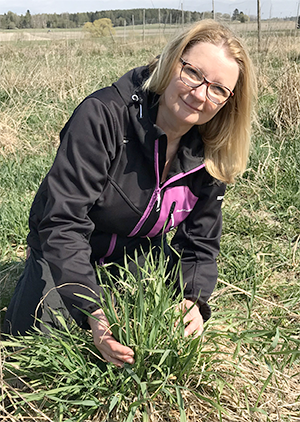 Anna Westerbergh
Anna Westerbergh
Associated Professor
Department of Plant Biology, SLU
E-mail: anna.westerbergh@slu.se
Telephone: +46 (0)18-67 33 40
CV-page
My current research on “Using wild plants and their genetic diversity for development of novel crops in a changing climate” was inspired by my previous research projects.
Read more about my previous research in the boxes below.
My current research on the wild crop relatives for the development of stress-tolerant and climate adapted crops was inspired by my previous research on wild populations within the plant family Caryophyllaceae.
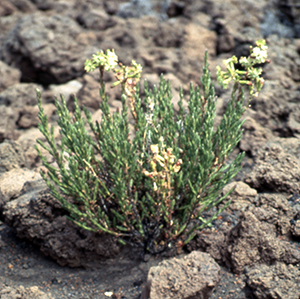
Silene struthioloides on lava flows on the Hawaiian island Maui.
Photo: Anna Westerbergh
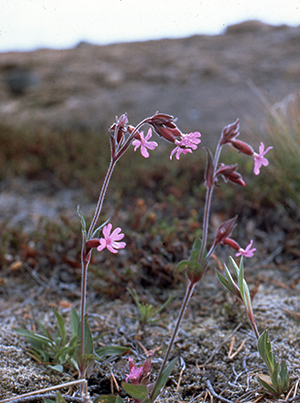
Silene dioica on serpentine in the Scandinavian Mountains.
Photo: Anna Westerbergh
During my PhD studies at Umeå University, I investigated the metal and drought tolerant wild plant Silene dioica on serpentine soils. I was also as a visiting PhD student at University of Hawaii at Manoa, studying the endemic Silene species on Hawaiian lava flows. My population and evolutionary studies on wild plant populations also included the polyploid and metal tolerant plant Cerastium alpinum and involved my first PhD student.
This research was mainly supported by the Swedish Council for Forestry and Agricultural Research (SJFR/Formas).
Westerbergh A, Nyberg A-B, 1995. Selective grazing of hairless Silene dioica plants by land gastropods. Oikos 73: 289-298, doi: 10.2307/3545953
Westerbergh A, Saura A. 1994. Gene flow and pollinator behaviour in Silene dioica populations. Oikos 71: 215-224, doi: 10.2307/3546269
Westerbergh A. 1994. Serpentine and non-serpentine Silene dioica plants do not differ in nickel tolerance. Plant and Soil 167: 297-303, doi: 10.1007/BF00007956
Westerbergh A. Saura A. 1992. The effect of serpentine on the population structure of Silene dioica (Caryophyllaceae). Evolution 46: 1537-1548, doi: 10.1111/j.1558-5646.1992.tb01143.x
Westerbergh A. 1992. The genetic basis of hairlessness in Silene dioica (Caryophyllaceae). Hereditas 117: 287-291, doi.org/10.1111/j.1601-5223.1992.tb00026.x
Westerbergh A. 2004. An interaction between a specialized seed predator moth and its dioecious host plant shifting from parasitism to mutualism. Oikos 105: 564-574, doi: 10.1111/j.0030-1299.2004.12820.x
Westerbergh A, Westerbergh J. 2001. Interactions between seed predators/pollinators and their host plants: a first step towards mutualism? Oikos 95: 324-334, doi: 10.1034/j.1600-0706.2001.950214.x
Westerbergh A, Saura A. 1994. Genetic differentiation in endemic Silene (Caryophyllaceae) on the Hawaiian Islands. American Journal of Botany 81: 1487-1493, doi: 10.2307/2445321
Nyberg Berglund A-B, Saura A, Westerbergh A. 2006. Electrophoretic evidence for disomic inheritance and allopolyploid origin of the octaploid Cerastium alpinum (Caryophyllaceae). Journal of Heredity 97: 296-302, doi.org/10.1093/jhered/esj029
Nyberg Berglund A-B, Dahlgren S, Westerbergh A. 2004. Evidence for parallel evolution and sitespecific selection of serpentine tolerance in Cerastium alpinum during the colonization of Scandinavia. New Phytologist 161: 199-209, doi: 10.1046/j.1469-8137.2003.00934.x
Nyberg Berglund A-B, Westerbergh A. 2001. Two postglacial immigration lineages of the polyploid Cerastium alpinum (Caryophyllaceae). Hereditas 134: 171-183, doi: 10.1111/j.1601-5223.2001.00171.x
My first interest in perennial crops started when I did my postdoctoral research on the genetic basis of morphological and adaptive trait differences between annual and perennial wild species relatives of maize, teosinte (Zea spp).
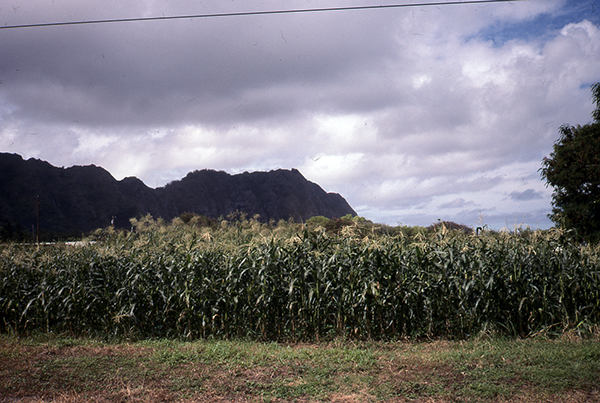
Mapping population from a cross between annual and perennial teosinte, wild relatives of maize. Photo: Anna Westerbergh
Using quantitative trait loci (QTL) mapping to investigate traits associated with perennialism, e.g. rhizome formation, taxonomic traits as tassel formation and adaptive traits as leaf pigmentation and pubescence, we showed that plant evolution under natural selection involves the full range of genetic mechanisms from a few QTL/genes of large effect to more numerous QTL/genes of small effect.
Collaboration: This work was carried out in Professor John Doebley’s lab at the University of Minnesota, USA.
Funding: Postdoctoral Fellowship from the Swedish Council for Forestry and Agricultural Research (SJFR/Formas).
Westerbergh A, Doebley J. 2004. Quantitative trait loci controlling phenotypes related to the perennial versus annual habit in wild relatives of maize. Theoretical and Applied Genetics109: 1544-1553, doi: 10.1007/s00122-004-1778-6
Lauter N, Gustus C, Westerbergh A, Doebley J. 2004. The inheritance and evolution of leaf pigmentation and pubescence in teosinte. Genetics167: 1949-1959, doi: 10.1534/genetics.104.026997
Westerbergh A, Doebley J. 2002. Morphological traits defining species differences in wild relatives of maize are controlled by multiple quantitative trait loci. Evolution 56: 273-283, doi: 10.1111/j.0014-3820.2002.tb01337.x
My interest in studies of plants adapted to stress-tolerant habits and plants with a perennial growth habit was combined in my research on cassava.
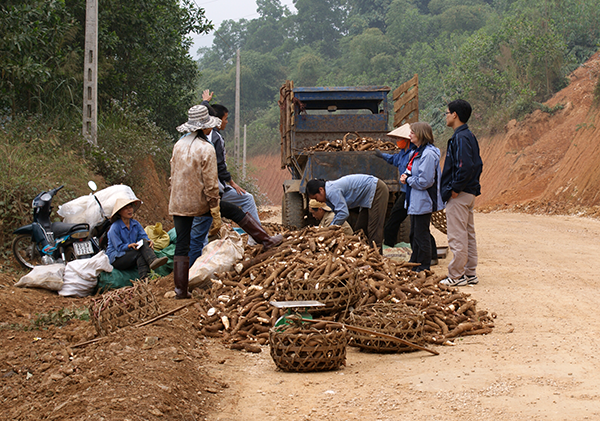
Cassava harvest in northern Vietnam. Photo Per-Olof Lundquist
This plant is a major staple crop in sub-tropical and tropical areas. It is drought tolerant and plays a major role in food security in a changing climate. Cassava was domesticated in South America and later introduced to Africa and East Asia. Uganda and Vietnam have very different history of cassava cultivation and for comparable studies we have investigated the genetic diversity and farmers’ selection of cassava varieties in these countries.
We used an interdisciplinary approach combining farmer interviews, trait and genetic marker analysis. Our work received the 2006 Outstanding Research Publication Award (ORPA) from the Board of Trustees at CIAT.
Collaboration: The cassava research involved PhD and Master students under my supervision.
Funding: The Swedish Agency for International Development (SIDA), Ministry of Foreign Affairs, Sweden, and the Swedish Research Council Formas.
Westerbergh A. 2013. Identification of cassava varieties meeting farmers’ preferences for participatory breeding. SLU Global Report 2013:2
Westerbergh A, Zhang J, Sun C. 2011. Cassava – a multipurpose crop for the future. In CM Pace (Ed.) Cassava: farming, uses, and economic impact (agriculture issues and policies). pp 145-163. Nova Science Publishers, Inc. Hauppauge, NY, USA. ISBN-10: 1612096557, ISBN-13: 978-1612096551
Jansson C, Westerbergh A, Zhang J, Hu X, Sun C. 2009. Cassava, a potential biofuel crop in (the) People’s Republic of China. Applied Energy 86: S95-S99, doi.org/10.1016/j.apenergy.2009.05.011
Baleyjusa Kizito E, Rönnberg-Wästljung A-C, Egwang T, Gullberg U, Fregene M, Westerbergh A. 2007. Quantitative trait loci controlling cyanogenic glycoside and dry matter content in cassava (Manihot esculenta Crantz). Hereditas 144: 129-136, doi: 10.1111/j.2007.0018-0661.01975.x
Balyejusa Kizito E, Chiwona-Karltun L, Egwang T, Fregene M, Westerbergh A. 2007. Genetic diversity and variety composition of cassava on small-scale farms in Uganda: An interdisciplinary study using genetic markers and farmer interviews. Genetica 130: 301-318, doi: 10.1007/s10709-006-9107-4
Received the 2006 Outstanding Research Publication Award (ORPA) from the Board of Trustees at CIAT. Also nominated for an Outstanding Research Publication Award at the CGIAR organization
Balyejusa Kizito E, Bua A, Fregene M, Egwang T, Gullberg U, Westerbergh A. 2005. The effect of cassava mosaic disease on the genetic diversity of cassava in Uganda. Euphytica 146: 45-54, doi: 10.1007/s10681-005-2959-3
 Anna Westerbergh
Anna WesterberghAssociated Professor
Department of Plant Biology, SLU
E-mail: anna.westerbergh@slu.se
Telephone: +46 (0)18-67 33 40
CV-page